
A mastodon is a member of the genus Mammut, which strictly defined, was endemic to North America and lived from the late Miocene to the early Holocene. Mastodons belong to the order Proboscidea, the same order as elephants and mammoths. Mammut is the type genus of the extinct family Mammutidae, which diverged from the ancestors of modern elephants at least 27-25 million years ago, during the Oligocene.
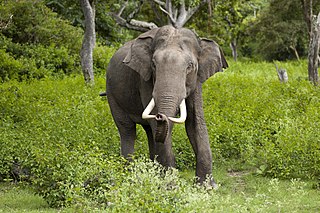
Elephantidae is a family of large, herbivorous proboscidean mammals collectively called elephants and mammoths. These are large terrestrial mammals with a snout modified into a trunk and teeth modified into tusks. Most genera and species in the family are extinct. Only two genera, Loxodonta and Elephas, are living.

Camelids are members of the biological family Camelidae, the only currently living family in the suborder Tylopoda. The seven extant members of this group are: dromedary camels, Bactrian camels, wild Bactrian camels, llamas, alpacas, vicuñas, and guanacos. Camelids are even-toed ungulates classified in the order Artiodactyla, along with species including whales, pigs, deer, cattle, and antelopes.

Lama is a genus containing the extant South American camelids: the wild guanaco and vicuña and the domesticated llama, alpaca, and chilihueque. Before the Spanish conquest of the Americas, llamas, alpacas, and chilihueques were the only domesticated ungulates of the continent. They were kept not only for their value as beasts of burden, but also for their flesh, hides, and wool.
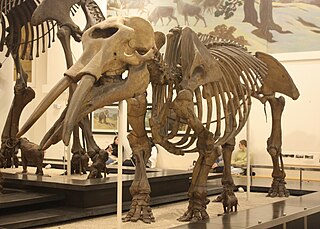
Gomphotheres are an extinct group of proboscideans related to modern elephants. They were widespread across Afro-Eurasia and North America during the Miocene and Pliocene epochs and dispersed into South America during the Pleistocene as part of the Great American Interchange. Gomphotheres are a paraphyletic group that is ancestral to Elephantidae, which contains modern elephants, as well as Stegodontidae. While most famous forms such as Gomphotherium had long lower jaws with tusks, which is the ancestral condition for the group, some later members developed shortened (brevirostrine) lower jaws with either vestigial or no lower tusks, looking very similar to modern elephants, an example of parallel evolution, which outlasted the long-jawed gomphotheres. By the end of the Early Pleistocene, gomphotheres became extinct in Afro-Eurasia, with the last two genera, Cuvieronius ranging from southern North America to western South America, and Notiomastodon having a wide range over most of South America until the end of the Pleistocene around 12,000 years ago, when they became extinct following the arrival of humans.
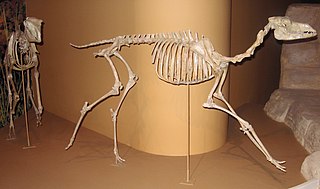
Stenomylus is an extinct genus of miniature camelid native to North America that is known from the Oligocene and Miocene epochs. Its name is derived from the Greek στενός and μύλος.

Carnassials are paired upper and lower teeth modified in such a way as to allow enlarged and often self-sharpening edges to pass by each other in a shearing manner. This adaptation is found in carnivorans, where the carnassials are the modified fourth upper premolar and the first lower molar. These teeth are also referred to as sectorial teeth.
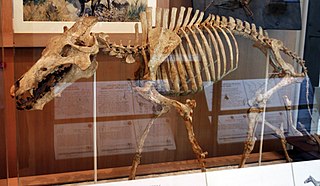
Archaeotherium is an extinct genus of entelodont artiodactyl endemic to North America during the Eocene and Oligocene epochs (35—28 mya), existing for approximately 9.1 million years. Archaeotherium fossils are most common in the White River Formation of the Great Plains, but it has also been found in the John Day Basin of Oregon and the Trans-Pecos area of Texas.
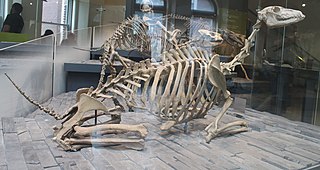
Poebrotherium is an extinct genus of camelid, endemic to North America. They lived from the Eocene to Miocene epochs, 46.3—13.6 mya, existing for approximately 32 million years.

Nothrotheriops is a genus of Pleistocene ground sloth found in North America, from what is now central Mexico to the southern United States. This genus of bear-sized xenarthran was related to the much larger, and far more famous Megatherium, although it has recently been placed in a different family, Nothrotheriidae. The best known species, N. shastensis, is also called the Shasta ground sloth.

Herpetotherium is an extinct genus of metatherian mammal, belonging to the possibly paraphyletic family Herpetotheriidae. Native to North America from the Eocene to Early Miocene, fossils have been found in California, Oregon, Texas, Florida, Montana, Wyoming, Colorado, North and South Dakota, Nebraska, and Saskatchewan. The oldest species, H. knighti, is dated to around 50.3 mya, and the most recent, an unnamed species, may be as recent as 15.97 mya. A morphological analysis of marsupials and basal metatherians conducted in 2007 found Herpetotherium to be the sister group to extant marsupials. It is the youngest known metatherian from North America until the migration of the Virginia opossum from South America within the last 2 million years.
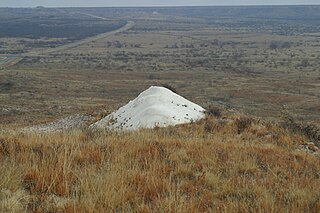
Mount Blanco is a small white hill — an erosional remnant — located on the eastern border of the Llano Estacado within Blanco Canyon in Crosby County, Texas. With Blanco Canyon, it is the type locality of the early Pleistocene Blanco Formation of Texas and Kansas, as well as the Blancan fauna, which occurs throughout North America. Mount Blanco is a Late Blancan age site, and is associated with other Late Blancan sites from Texas such as Red Light and Hudspeth local faunas from Hudspeth County, and the Cita Canyon fauna from Randall County.
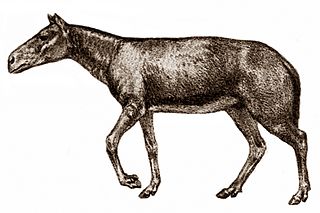
Archaeohippus is an extinct three toed member of the family Equidae known from fossils of early Oligocene to middle Miocene age. The genus is noted for several distinct skeletal features. The skull possesses deeply pocketed fossa in a notably long preorbital region. The genus is considered an example of phyletic dwarfism with adults estimated at being on average 20kg in weight. This is in contrast to the most common equid of the period, Miohippus. Characters of the teeth show a mix of both primitive and advanced traits. The advanced traits are very similar to those shown in the genus Parahippus. The noted similarities of Archaeohippus and Parahippus show them to be descended from a common ancestor and are considered sister species.
Paracamelus is an extinct genus of camel in the family Camelidae. It originated in North America and crossed the Beringian land bridge into Eurasia during the Late Miocene, approximately 7.5–6.5 million years ago (Ma). It is the presumed ancestor to living camels of the genus Camelus.
Pleiolama is an extinct genus of terrestrial herbivore in the family Camelidae, endemic to North America during the Pliocene.

Aphelops is an extinct genus of hornless rhinocerotids endemic to North America. It lived from the Middle Miocene to the early Pliocene, during which it was a common component of North American mammalian faunas along with Teleoceras.
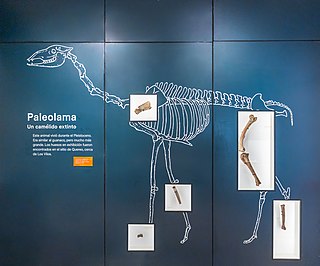
Palaeolama is an extinct genus of laminoid camelids that existed from the Late Pliocene to the Early Holocene. Their range extended from North America to the intertropical region of South America.

Lamini is a tribe of the subfamily Camelinae. It contains one extant genus with four species, all exclusively from South America: llamas, alpacas, vicuñas, and guanacos. The former two are domesticated species, while the latter two are only found in the wild. None display sexual dimorphism. The four species can interbreed and produce fertile offspring. Additionally, there are several extinct genera.
Uruguayodon is an extinct genus of proterotheriid from the middle Pleistocene of Uruguay. It is known from the type and only species U. alius, named by Corona and colleagues in 2019 for dentaries and a partial postcrania from the Raigón Formation. Uruguayodon represents one of the latest occurrences of Proterotheriidae, with only Neolicaphrium representing other remains from the Pleistocene to possibly Holocene.
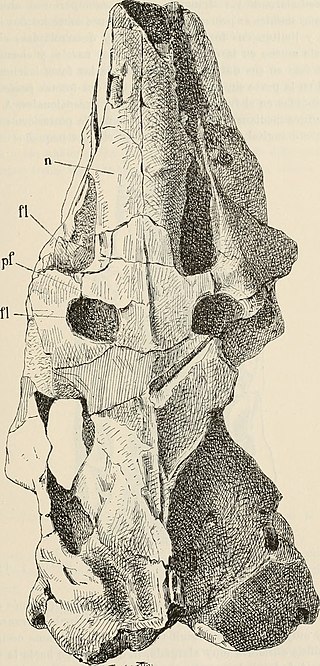
Hemihegetotherium is an extinct genus of hegetotheriid notoungulate that lived from the Middle to the Late Miocene of what is now Argentina.



















